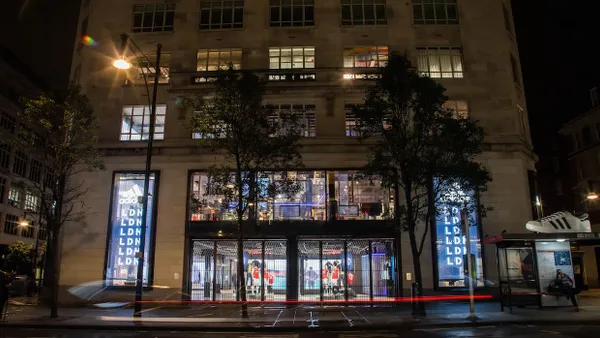Dive Brief:
-
Nike revenue declined 38% in the fourth quarter, falling to $6.3 billion, according to a company press release. The retailer swung to a loss of $790 million, from income of $989 million the year before. That represented a 180% decline.
-
While revenues in Greater China were only down 3%, North America was down 46% to $2.2 billion. As stores reopen, revenues are expected to improve and for fiscal year 2021, the company expects revenue to be flat to up, CFO Matt Friend said on a conference call with analysts.
-
In the wake of strong digital growth in the quarter (75%), the retailer announced a new phase of its consumer direct strategy, with three key areas of acceleration: the creation of a "marketplace of the future," the realignment of product categories for a new consumer construct and further investment in digital.
Dive Insight:
While Nike's results were lower than anticipated in Q4, executives remained staunchly focused on the future.
In connection with its consumer direct offense, the retailer is planning to open between 150 and 200 new smaller footprint stores in North America, Europe, the Middle East and Africa, in the image of the Nike Live concept it's been testing for a few years now. Those stores will be opened in the next couple of years, according to executives. The retailer tested the concept in Melrose initially, but has expanded it to several more locations, and plans to shift two stores in New York to the Nike Live model.
That concept has also been used to inform the retailer's House of Innovation flagship stores, which boast many of the same digitally enabled features.
Another of the company's accelerations is focused on reinvesting in its women's and kid's businesses, which both provide growth opportunities for the company. All of the initiatives, however, are focused on digital.
Executives said digital represented nearly 30% of the company's total business in Q4, and original plans for digital to reach 30% penetration by 2023 are now set to be hit in 2021. The company now expects its overall business to reach 50% digital penetration.
"The global pandemic has made it clear that consumer behavior is changing rapidly, providing the opportunity for us to accelerate the pace of our transformation," CEO John Donahoe said on the call. "Over the past few years, we have shifted from a legacy, wholesale distribution model to investment in a model that gives our consumers a more premium shopping experience."
That premium shopping experience means pulling out of partnerships that don't serve its purposes, like Amazon, and focusing instead on selling directly to the consumer, which is "financially accretive" to Nike. Donahoe, referring to it as the "one-Nike marketplace," highlighted that the strategy "leads with Nike Digital" and the company's owned stores, and includes only "a small number of strategic partners."
"If a retailer fails to enhance the Nike brand (and Nike is the judge), then said retailer will likely have allocations for key product reduced or cutoff," Susquehanna Financial Group analysts led by Sam Poser, said in emailed comments. "Nike has the keys to most every large and small athletic retailers' success, and those keys are becoming more valuable."















